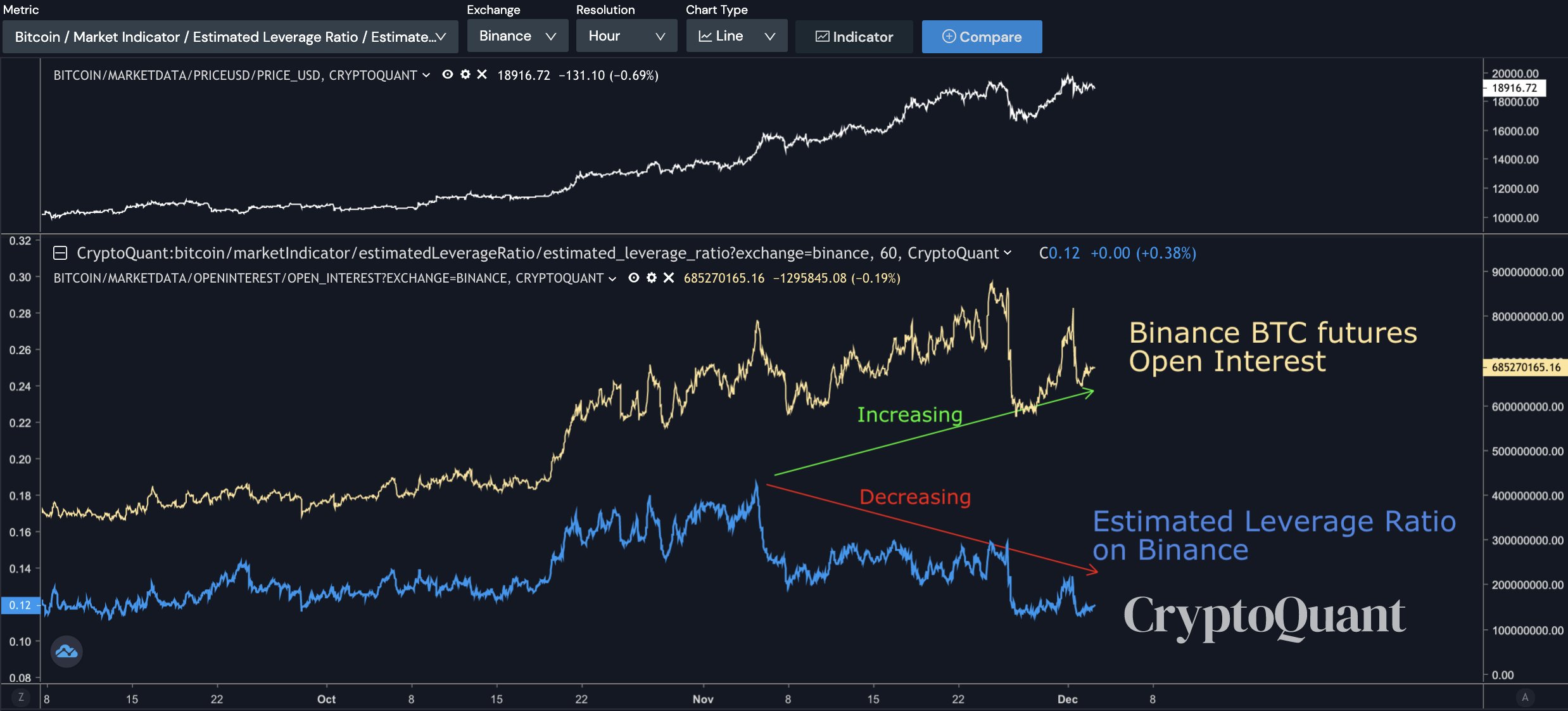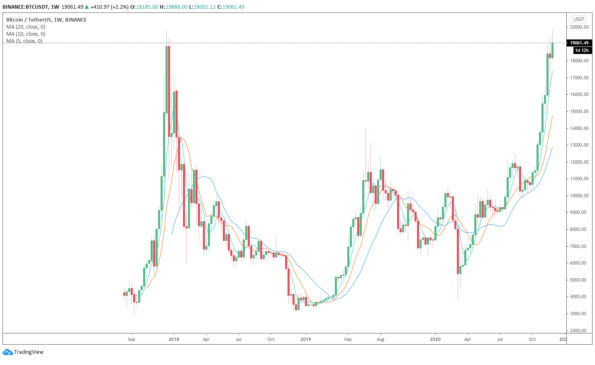The price of Bitcoin (BTC) was rejected by the $19,500 resistance level yet again on Dec. 4, with traders becoming increasingly uncertain about what’s next for BTC/USD.
Bitcoin rally keeps stalling at $19,500
Some foresee the dominant cryptocurrency undergoing a consolidation phase or another minor correction in the near term, particularly as the U.S. dollar is showing signs of a possible recovery.
Others, however, expect the crucial $18,500 support level to hold, which would likely set up BTC to retest the key $20,000 level and a new all-time high in the near future.
In the short term, traders generally foresee two important support and resistance levels for Bitcoin. First, the $18,500 area is critical to ensure that the bullish market structure of BTC holds. Second, The $19,500 level is a massive resistance level for BTC. If BTC surpasses $19,500, traders expect a new run-up toward the all-time high that’s currently just under $20,000.
Meanwhile, Bitcoin is becoming more difficult to trade because of the volatility at the $19,500 resistance level. BTC saw a severe sell-off every time this area was tested in the past week.
A pseudonymous trader known as “CryptoGainz” believes that the ideal entry point for Bitcoin traders is now above the $19,500 resistance level. However, this may not be the case for two reasons: it puts traders at risk of a steep sell-off at the record high once again as $20,000 remains a high-risk sell wall for the bulls. He said:
“What’s annoying about this price action for me is that if my bids don’t get hit I’m forced to long the breakout, which at this point puts me around 19.7k or higher Meaning my entry isn’t safe from a pullback unless there’s an epic (read: 10%+) impulse move from that level.”
Whales selling below the all-time high is the one key reason Bitcoin is experiencing massive volatility each time it nears $19,500.
CryptoQuant CEO Ki Young Ju told Cointelegraph explained that whale inflows hit an eight-month high when BTC got close to $20,000. The combination of whales and miners selling heavily puts BTC at risk of a correction, Ju noted.
In the near term, this could mean that Bitcoin could face weeks of sideways consolidation or a deeper correction, according to Ki. Moreover, he added that exchange reserves are not declining as they did throughout mid-2020. It shows that whales might be leaving BTC on exchanges to sell if the price of Bitcoin rises. He explained:
“If you look at all exchanges inflow mean(144-block MA), it hit over 2 BTC a few hours ago. We hit 2.5 BTC when the price was tapping $20k. It was the eight-month high since the March great sell-off. Looking at all exchanges outflow mean(72h MA), whales are no longer withdrawing from exchanges. They keep BTC on exchanges to make them available to sell I think. Looking at the Miners’ Position Index, miners are selling BTC pretty heavily.”
The bullish case for Bitcoin in the near term
If Bitcoin rises above the heavily-shorted $19,500 resistance level, buyers have a chance to regain control over the market.
A pseudonymous trader known as “CryptoCapo” said that “bears don’t want to see price above $19,500,” while bulls do not want the price to go below $18,500.
Nevertheless, if the bulls prevail here, the $20,000 level would be the next — and perhaps the more psychologically important — area to defend for the bears, in the near term. Other traders, like CryptoGainz, similarly said that $19,650 is the level that may trigger a new breakout for Bitcoin in the near future.
Meanwhile, MicroStrategy, the $3 billion business intelligence conglomerate, has just bought an additional $50 million in Bitcoin at the current price level, which yet another optimistic factor for Bitcoin.
MicroStrategy has purchased approximately 2,574 bitcoins for $50.0 million in cash in accordance with its Treasury Reserve Policy, at an average price of approximately $19,427 per bitcoin. We now hold approximately 40,824 bitcoins.https://t.co/nwZcM9zAXZ
— Michael Saylor (@michael_saylor) December 4, 2020
The public company first announced its purchase of $250 million worth of BTC on Aug. 11, as Cointelegraph reported. In September, the firm bought another $175 million worth of BTC, bringing its BTC holdings to about 38,000 BTC. MicroStrategy doubling down on its purchase shows that the firm believes $19,000 could be a launchpad for Bitcoin’s next rally.
This news also comes as Grayscale has already added thousands of Bitcoin to its holdings in December alone. As Cointelegraph reported earlier this week, the Grayscale Bitcoin Trust bought 55,000 BTC in November, or double the amount of the total BTC mined that month.
Therefore, it remains to be seen if this institutional buying could offset the bearish selling by whales and miners in the month ahead.
The short-term bearish case
Technically, the bearish scenario for Bitcoin in the upcoming days revolves around the $18,500 support level. If BTC loses the support and falls below $18,500, technical analysts say that a larger drop could occur. Below $18,500, the next major macro support area is the $16,000 to $16,500 range, which BTC tested on Nov. 26.
Michael van de Poppe, a full-time trader at the Amsterdam Stock Exchange, noted that Bitcoin falling under $18,500 would likely mean retesting the $16,000 support area. If BTC keeps getting rejected by the $19,150 and $19,400 resistance levels, the probability of a drop will continue to rise.
Van de Poppe explained:
“And as $19,400 and $19,150 rejected, the range low was tested at the $18,500 area, tweeted yesterday. All fine, range-bound construction further. Breaking $19,400 = new ATH. Losing $18,500 = likely $16K tests.”
As a result, the futures market has been showing uncertainty from traders in the past several days. Data from CryptoQuant show that Bitcoin futures traders have been using lower leverage as of late. This indicates that traders anticipate large price swings and potentially steep sell-offs to occur.

Analysts at CryptoQuant found that open interest on Binance Futures is rising while the estimated leverage ratio is declining, which suggests that traders are becoming increasingly cautious and uncertain about Bitcoin’s next move.
One variable that can spark a new BTC rally
The calls for a Bitcoin correction have been increasing, even from several permabulls. Raoul Pal, the CEO of Real Vision Group, for example, pointed out that technicals suggest BTC is at risk of seeing a correction. The DeMark system shows the daily chart of Bitcoin is on track for a record 13 consecutive positive candles.
Bitcoin is potentially facing some serious technical headways… the daily DeMark is showing a cluster on 2 13’s and a 9 and tomorrow might put in ANOTHER 13! pic.twitter.com/TNPpLfR2nH
— Raoul Pal (@RaoulGMI) December 4, 2020
But, one variable that may allow Bitcoin to continue grinding upward is the Relative Strength Index (RSI) on the yearly chart. Currently, the RSI of Bitcoin is hovering at 75, which means that it is not yet in overbought territory.
An asset is considered to be extremely bought when the RSI rises above 90. Considering the general momentum of BTC, alongside increasing institutional interest, BTC bulls still have a good chance of breaking through the key $19,500 and $20,000 resistances.




